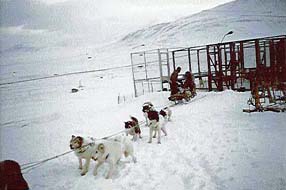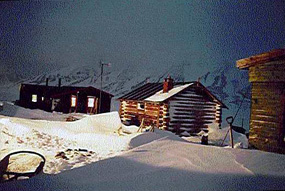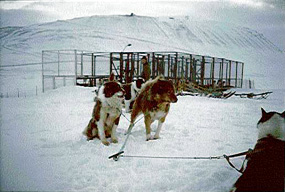Table of Contents
*
Featured Inuit Dog Owner: Brian and Linda Fredericksen
*
Lake Nipigon - Solo
*
Inuit Dogs in New Hampshire, Part II
*
The Inuit Dogs of Svalbard
*
Update: Uummannaq Children's Expedition
*
Update: Iqaluit Dog Team By-Law is Official
*
Poem: Instinct
*
The Homecoming: Epilogue
*
Product Review: Sock Sense
*
Tip for the Trail: Wet Equals Cold
*
Janice Howls: More Than Meets the Eye
*
Page from a Behaviour Notebook: Hunting
Navigating This
Site
Index of articles by subject
Index
of back issues by volume number
Search The
Fan Hitch
Articles
to download and print
Ordering
Ken MacRury's Thesis
Our
comprehensive list of resources
Talk
to The Fan
Hitch
The Fan
Hitch home page
ISDI
home page
Editor: Sue Hamilton
Webmaster: Mark Hamilton
Contents of The Fan Hitch Website and its publications are protected by international copyright laws. No photo, drawing or text may be reproduced in any form without written consent. Webmasters please note: written consent is necessary before linking this site to yours! Please forward requests to Sue Hamilton, 55 Town Line Rd., Harwinton, Connecticut 06791, USA or mail@thefanhitch.org

Starting out from the kennel Socha photo
The Inuit Dogs of Svalbard
by Tim Socha
Svalbard (the cold coast), or Spitzbergen as it is often wrongly termed, is a group of islands that lie at seventy-eight degrees North of the coast of Norway. Although it is warmed on the west coast by the Gulf Stream, it is covered with glaciers. The islands are inhabited by polar bears, (it has protected denning areas) arctic fox, Svalbard caribou (similar to the Peary caribou), marine mammals, and in summer lots of migratory sea birds. Svalbard was never settled by the Inuit, and human habitation is a very recent phenomena. Longyearbyn is served by jets on a daily basis, so it has lost its "pioneer" atmosphere. For those interested, you can find plenty of information on the internet.
To my knowledge, the first Greenland Inuit Dogs arrived there with Wally Herbert on his crossing from the Canadian Arctic over the North Pole to Svalbard. Those dogs later died out, but it was soon realized that the GISDs were the perfect choice for that environment, and a Norwegian strain was brought to the Islands. Ove Nygard has more details about the GISD in Norway.
Robin Buzza, who runs Arctic Wilderness Experience (AWE), moved to Longyearbyn in the 1960's. He has a kennel of forty to fifty GISDs. The actual enclosure is interesting because it is about four to five meters high! This is to keep the dogs in even when the drifting snow get very high. There was a movement to ban the GISD a few years ago, because a few dogs got loose and did what comes naturally, to kill and eat a caribou, unfortunately right in front of a group of shocked tourists.
AWE takes small groups into the interior of Svalbard. Very much "hands on", Robin's trips require a good level of fitness. When I first met Robin and then got to know his dogs, our "kinship" was clear. One of his dogs was named Hinza, a Bushman name from Lauren Van Der Post's book "A Story Like the Wind" which I liked very much. Hinza also had a ridge of hair growing the wrong way along his spine just like the dog in the book.
Robin uses Nansen Sleds, which are equipped with a hand activated brake. The Nansen Sleds are not ridden. You ski behind the sled attached to a tow/safety line. Clients are supplied with a pair of Acton boots, Norwegian military skis equipped with Swedish military cable bindings and poles. The group gear consists of cotton pyramid tents, Primus stoves, reindeer skins to sleep on, and of course food. Clients have to bring suitable Arctic climate clothing and other personal gear. The guides I met while at Robin's were very competent.
While on the trail, the dogs are fed seal meat, dried fish and caribou as opposed to the kibble they usually get. Robin's greatest problem with dog maintenance is getting a supply of bones for the dogs to chew.

Robin's
Camp
Socha
photo
The daily routine, after breakfast is to break camp, then start off for the day, only taking short breaks for tea and snacks until camp is set up for the night. The preferred location is a place with relatively deep snow in order to picket the dogs safely around the tents as a precaution against polar bears.
Polar bear visits are naturally a topic of discussion when going out on a trip with Robin. Normal procedure is first of all to stay alert, constantly scanning the horizon. I personally don't trust other people's abilities and judgment with firearms, and I have always been armed when on one of his trips. There have been several fatalities in Svalbard, so the government recommends at least a .30-06 rifle for safety. It is also typical to carry a flare pistol. This is the first line of defense, to shoot flare in front of an approaching bear, and also to throw "thunder flashes". Shooting to kill is the absolute last line of defense. Robin has regular visits from bears who just wanted to look over the camp and leave again. It's generally possible to scare away the bears, dogs being the very best deterrent. The dogs have the ability to spot the bears intentions from several hundred meters away.
The dogs follow voice commands, so talking while traveling is not the rule. I have found this exceedingly refreshing. My personal schedule has only allowed me to visit Svalbard four times now. I have done two trips out of season with AWE in February. These have both been pretty tough trips, but wonderful experiences. I find it refreshing to go out with a dog team, being forced to focus on the moment, where the priorities are keeping moving to stay warm, staying on your feet and setting and breaking up camp and of course taking in the awesome beauty of the nature there.
It is Robin's wish, as AWE says, to allow people to experience the Arctic. The tendency in Longyearbyn though is to build up the "quick fix" tourism. That means flying in, staying in a hotel, maybe taking a day trip by snowmobile with a hoard of other guest, cocktails at night, and a short ride with a dog sled the next day. Svalbard is sadly, very much endangered by this kind of tourism, as well as by the irresponsible exploitation of the buried coal. There are a few newer firms that cater to this kind of tourism, but as Robin observes, having a kennel like his is not only a business but a lifestyle.
I am grateful that I have had the chance to visit Svalbard, and hope to go again, but this time with my own two CISDs as company.

Hinza &
Wally
Socha
photo